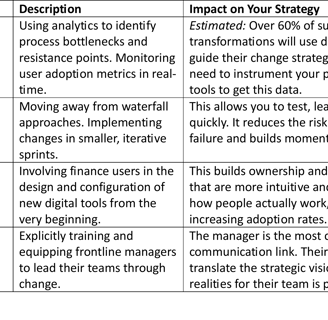Your Digital Finance Future Won't Build Itself
Carl Beebe
Your finance shared services center is staring down the barrel of significant change. New digital tools and modernized processes are no longer optional. But here’s a hard truth: the best technology in the world is useless if your team won't adopt it. Successful transformation hinges on deliberate and effective change management best practices. This is not about soft skills; it is about a hard-nosed, structured approach to de-risking your investment and achieving your ROI.
Many leaders mistakenly believe that a go-live date is the finish line. However, in my view it’s only the starting point. Without a clear plan to manage the human side of the technology equation, you are planning for failure.
The New Fundamentals of Finance Change
The old playbook for change management - a one-off communication blast and some generic training is obsolete. Today's environment of continuous technological advancement requires a more dynamic approach.
Continuous Engagement, Not Big-Bang Communication: Your team should hear about changes early and often. Don't wait until you have all the answers. Share the "why" behind the process modernization. Explain the business drivers and the direct benefits to them, such as eliminating tedious, manual tasks. Use multiple channels: town halls, team huddles, and direct manager conversations.
Champions on the Ground: Identify and empower change champions within your teams. These are not necessarily managers. They are the influential, respected individuals who others turn to for advice. Give them early access to new tools, involve them in testing, and make them your advocates. Their peer-to-peer influence is more powerful than any top-down directive.
Training That Sticks: Generic, one-size-fits-all training is a waste of resources. Modern learning should be role-based, on-demand, and integrated into the flow of work. Think short video tutorials, guided in-app walkthroughs, and readily accessible job aids. The goal is competence and confidence, not just attendance.
Top Trends Driving Change in Finance Shared Services
We are observing a clear shift in how high-performing organizations manage technology-driven change. These are not theoretical ideas; they are practices being implemented now.


Acknowledge and Manage the Risks
Ignoring the risks associated with process modernization is a recipe for disaster. Be prepared for them.
Change Fatigue is Real: Your teams are likely being hit with multiple initiatives at once. Prioritize your change portfolio. If everything is a priority, nothing is. Be realistic about your organization's capacity to absorb change.
Productivity Dips are Inevitable: There will be a learning curve. Expect a temporary dip in productivity as your team adapts to new processes and tools. Plan for this in your forecasting and communicate it to your stakeholders. This is a known, quantifiable risk you can buffer against.
Perceived Loss of Control: Automation can feel threatening. Staff may worry that their roles are becoming obsolete. Your communication must focus on how technology augments their skills, freeing them for higher-value analytical and strategic work. Frame it as an evolution of their role, not an elimination of it.
Emerging and Future Trends to Watch
Looking ahead, the nature of change itself is evolving. The line between technology implementation and business-as-usual is blurring.
The Rise of the "Change-Ready" Culture: The future state is not a static destination. Market-leading shared services will operate in a state of perpetual evolution. Your focus will shift from managing discrete change projects to building a culture that is inherently adaptable and resilient.
AI in Change Management: Expect AI-powered tools to emerge that can predict resistance hotspots, personalize training content, and provide real-time sentiment analysis of employee feedback.
Hyper-Personalization: Just as you personalize customer experiences, you will need to personalize the change experience for your employees. Different demographics and roles will require different communication styles, training formats, and support structures.
Wisdom to Action: Your role as a leader is to guide your organization through this transition. By implementing robust change management best practices, you are not just installing new software; you are building a more agile and competitive finance function for the future.
